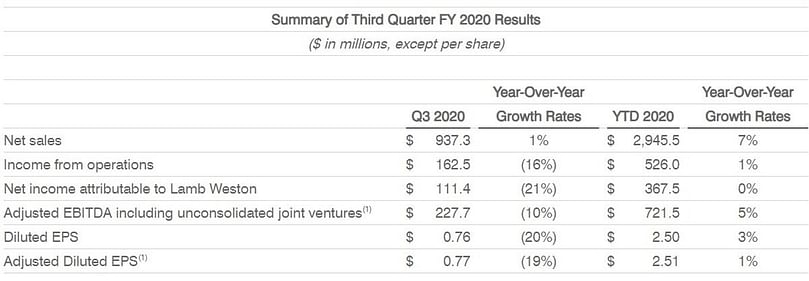Lamb Weston withdraws Fiscal Year 2020 Outlook due to uncertainty from the COVID-19 Pandemic’s Effect on Global Restaurant Traffic and Consumer Demand.
Potato Processor Lamb Weston Reports Fiscal Third Quarter 2020 Results

Lamb Weston Holdings, Inc. (NYSE: LW) announced its fiscal third-quarter 2020 results.
Tom Werner, President, and CEO at Lamb Weston Holdings, Inc :
“Our results in the third quarter were mixed.”
“We drove solid growth in our Foodservice and Retail segments, but our Global segment’s sales declined due to the timing of sales of customized products and higher-margin limited-time offering products, as well as the initial effects of the COVID-19 pandemic on restaurant traffic in China. In addition, all our segments had fewer shipping days related to the timing of the Thanksgiving holiday. We also realized the impact of higher-than-expected input and fixed cost inflation, which pressured earnings.”
“While the operating environment in most of our markets during the fiscal third quarter was favorable, estimates on the COVID-19 pandemic’s effect on the global economy are uncertain.”
“At this time, despite only two months remaining in our fiscal fourth quarter, we are unable to reasonably forecast frozen potato product demand because of the pandemic’s unpredictable near-term effect on restaurant traffic in North America and our key international markets. As a result, we’re withdrawing our financial outlook for the remainder of our fiscal year.”
“During these uncertain times, our top priorities are to ensure the health and welfare of our employees, maintain product safety, and continue to support our customers as they work to manage their supply chains and inventories. While the near-term impact of the COVID-19 pandemic on consumer demand and sales volume is likely to be material, we believe we have sufficient liquidity to manage through the uncertainty, and we remain confident in the long-term outlook for our customers and the continued growth of the global category.”
Q3 2020 Commentary
Net sales increased $10.5 million to $937.3 million, up 1 percent versus the year-ago period. Price/mix increased 1 percent due to pricing actions, partially offset by unfavorable mix. Volume was flat as growth in the Foodservice segment was partially offset by a decline in the Global segment’s volume, primarily due to the timing of sales of customized products (products manufactured to a customer’s unique specifications) and higher-margin limited-time offering products, as well as the initial effects of the COVID-19 pandemic on restaurant traffic in China.
In addition, acquisitions contributed more than 1 percentage point of the volume increase, which was largely offset by an approximate 1 percentage point decline from the effect of fewer shipping days, compared with the prior-year period, related to the timing of the Thanksgiving holiday.
Income from operations declined $31.3 million, or 16 percent, to $162.5 million versus the year-ago period, reflecting lower gross profit and higher selling, general and administrative expense (“SG&A”). Gross profit declined by $23.0 million. Higher manufacturing costs due to input and fixed cost inflation drove most of the decline.
An additional $4.3 million of the decline reflects the change in unrealized mark-to-market adjustments and realized settlements associated with commodity hedging contracts, which includes a $0.3 million loss in the current quarter, compared with a $4.0 million gain related to these items in the prior-year quarter.
The remainder of the gross profit decline was driven by higher transportation costs; unfavorable customer mix; costs resulting from COVID-19-related production interruptions in China; and higher depreciation expense primarily associated with the Company’s french fry production line in Hermiston, Oregon, which started operating towards the end of the fourth quarter of fiscal 2019.
SG&A increased $8.3 million, largely driven by investments in the Company’s sales, operating and systems capabilities, including approximately $2 million of non-recurring expenses, primarily consulting expenses, associated with developing and implementing a new enterprise resource planning ('ERP') system. The increase also reflects an approximate $3 million impact of unfavorable foreign exchange, which was partially offset by a $2.3 million decline in advertising and promotional expenses.
Net income attributable to Lamb Weston decreased $30.0 million, or 21 percent, to $111.4 million, primarily reflecting a decline in income from operations, lower equity method earnings, which included a $2.6 million ($2.0 million after-tax) loss related to the withdrawal from a multiemployer pension plan by the Company’s joint venture, Lamb-Weston/RDO Frozen ('Lamb Weston RDO'), and a higher effective tax rate.
Adjusted EBITDA including unconsolidated joint ventures(1) decreased $25.5 million to $227.7 million, down 10 percent versus the prior-year period, due to a decline in income from operations.
Diluted EPS decreased $0.19, or 20 percent, to $0.76. The decrease largely reflects a decline in income from operations, lower equity method investment earnings, and a higher effective tax rate.
Adjusted Diluted EPS(1), which excludes the loss related to the withdrawal from a multiemployer pension plan by Lamb Weston RDO, decreased $0.18, or 19 percent, to $0.77.
The Company’s effective tax rate(2) in the third quarter of fiscal 2020 was 24.3 percent, versus 21.9 percent in the prior-year period. The effective tax rate varies from the U.S. statutory tax rate of 21 percent principally due to the impact of U.S. state taxes, foreign taxes, permanent differences, and discrete items.
Cash Flow
Through the third quarter of fiscal 2020, net cash from operating activities declined $8.7 million to $435.7 million, primarily due to increased working capital requirements. Capital expenditures, including information technology expenditures, were $152.0 million in the first three quarters of fiscal 2020, down $95.3 million versus the prior-year period due to investments for the construction of a production line in Hermiston, Oregon, which was completed in the fourth quarter of fiscal 2019.
On February 23, 2020, the Company had no borrowings on its revolving credit facility. During the latter part of March 2020, the Company borrowed $495 million on its revolving credit facility to increase its cash position as a precautionary measure in order to preserve financial flexibility considering the uncertainty in the global markets resulting from the COVID-19 pandemic.
Capital Returned to Shareholders
In the first three quarters of fiscal 2020, the Company returned a total of $110.6 million to shareholders, including $87.7 million in cash dividends and $22.9 million through share repurchases. The average price per share repurchased was $79.56. The Company has approximately $195.3 million remaining under its current $250 million share repurchase authorization.
Given the uncertainty of the COVID-19 pandemic’s impact, the Company has temporarily suspended share repurchases to provide additional liquidity until there is more clarity about the future operating environment.
Q3 2020 Segment Highlights
Global
Net sales for the Global segment, which is comprised of the top 100 North American based restaurant chain customers as well as the Company’s international business, decreased $11.1 million to $487.1 million, down 2 percent compared to the prior-year period. Volume decreased 1 percent, primarily due to higher sales of customized products and higher-margin limited-time offering products in the prior-year period, as well as the initial effects of the COVID-19 pandemic on restaurant traffic in China.
The Global segment sells the majority of the Company’s customized products, for which revenue is recognized when a purchase order is received to the extent the product has been manufactured, as opposed to sales of non-customized products, for which revenue is generally recognized upon shipment.
As a result, the timing of the receipt of a purchase order may create quarterly fluctuations in this segment. In addition, acquisitions contributed approximately 2 percentage points of volume growth, which was partially offset by an approximate 1 percentage point decline from the effect of fewer shipping days related to the timing of the Thanksgiving holiday.
Price/mix decreased 1 percent, largely due to unfavorable mix resulting from lower sales of customized products and limited-time offering products versus the prior-year period, customer mix in North America, and a higher proportion of growth in international sales volumes.
Global segment product contribution margin decreased $19.5 million to $109.3 million, down 15 percent compared to the prior-year period. Higher manufacturing costs due to input and fixed cost inflation, lower sales volumes, and unfavorable product and customer mix drove most of the decline.
The effect of the COVID-19 pandemic on consumer demand and manufacturing costs in China, higher transportation costs, and higher depreciation expense primarily associated with the new Hermiston production line, also pressured the segment’s profitability.
Foodservice
Net sales for the Foodservice segment, which services North American foodservice distributors and restaurant chains outside the top 100 North American based restaurant chain customers, increased $17.5 million to $283.0 million, up 7 percent compared to the prior-year period.
Price/mix increased 4 percent, primarily reflecting pricing actions initiated in the fall of 2019 and improved mix.
Volume increased 3 percent, led by growth in distributor private label and Lamb Weston branded products, partially offset by a more than 2 percentage point impact from the effect of fewer shipping days related to the timing of the Thanksgiving holiday.
Foodservice segment product contribution margin increased $5.0 million to $99.8 million, up 5 percent compared to the prior-year period, as favorable price/mix and volume growth more than offset input and fixed cost inflation, as well as higher transportation costs and depreciation expense primarily associated with the new Hermiston production line.
Retail
Net sales for the Retail segment, which includes sales of branded and private label products to grocery, mass merchant and club customers in North America, increased $3.2 million to $132.2 million, up 2 percent compared to the prior-year period. Price/mix increased 2 percent, largely driven by favorable mix.
Volume was flat as higher sales of Grown in Idaho and other branded products were offset by lower sales of private label products, as well as an approximate 2 percentage point impact from the effect of fewer shipping days related to the timing of the Thanksgiving holiday.
Retail segment product contribution margin decreased $0.3 million to $28.8 million, down 1 percent compared to the prior-year period, as input and fixed cost inflation, as well as higher transportation costs and depreciation expense primarily associated with the new Hermiston production line, more than offset favorable price/mix and lower advertising and promotional expenses.
Equity Method Investment Earnings
Equity method investment earnings from unconsolidated joint ventures in Europe, the U.S., and South America were $9.8 million and $14.2 million for the third quarter of fiscal 2020 and 2019, respectively. Earnings in the current quarter included a $2.6 million loss related to the withdrawal from a multiemployer pension plan by Lamb Weston RDO.
Equity method investment earnings also included a $7.3 million unrealized loss related to mark-to-market adjustments associated with currency and commodity hedging contracts in the current quarter and a $0.9 million loss related to these items in the prior-year quarter.
Excluding the Lamb Weston RDO pension-related comparability item and the mark-to-market adjustments, earnings from equity method investments increased $4.6 million compared to the prior-year period, largely reflecting lower raw potato prices and higher sales volumes in Europe.
Outlook
The Company has withdrawn its financial outlook for the fiscal year 2020 for net sales growth and for Adjusted EBITDA including unconsolidated joint ventures(1). At this time, the Company does not believe it can reasonably forecast frozen potato product demand in the near term due to the unpredictable near-term effect of the COVID-19 pandemic on the global economy, and more specifically, on restaurant traffic in North America and key international markets, including markets served by the Company’s joint ventures.
The Company’s previous outlook included the contribution of a 53rd week in the fiscal 2020 period, with the additional week falling in the fourth quarter.
The Company continues to expect for fiscal 2020:
- Interest expense of approximately $110 million;
- An effective tax rate(2) excluding comparability items of approximately 24 percent; and
- Depreciation and amortization of approximately $175 million.
In addition, the Company reduced its target for capital expenditures to approximately $200 million from approximately $300 million as the Company plans to defer certain capital expenditures.
End Notes
(1) Adjusted EBITDA including unconsolidated joint ventures and Adjusted Diluted EPS are non-GAAP financial measures. Please see the discussion of non-GAAP financial measures and the reconciliations at the end of this press release for more information.
(2) The effective tax rate is calculated as the ratio of income tax expense to pre-tax income, inclusive of equity method investment earnings.
(3) For more information about product contribution margin, please see the table titled 'Segment Information' in this press release.
Like to receive news like this by email? Join and Subscribe!
Get the latest potato industry news straight to your WhatsApp. Join the PotatoPro WhatsApp Community!
Highlighted Company
Sponsored Content
Sponsored Content
Sponsored Content
Sponsored Content















